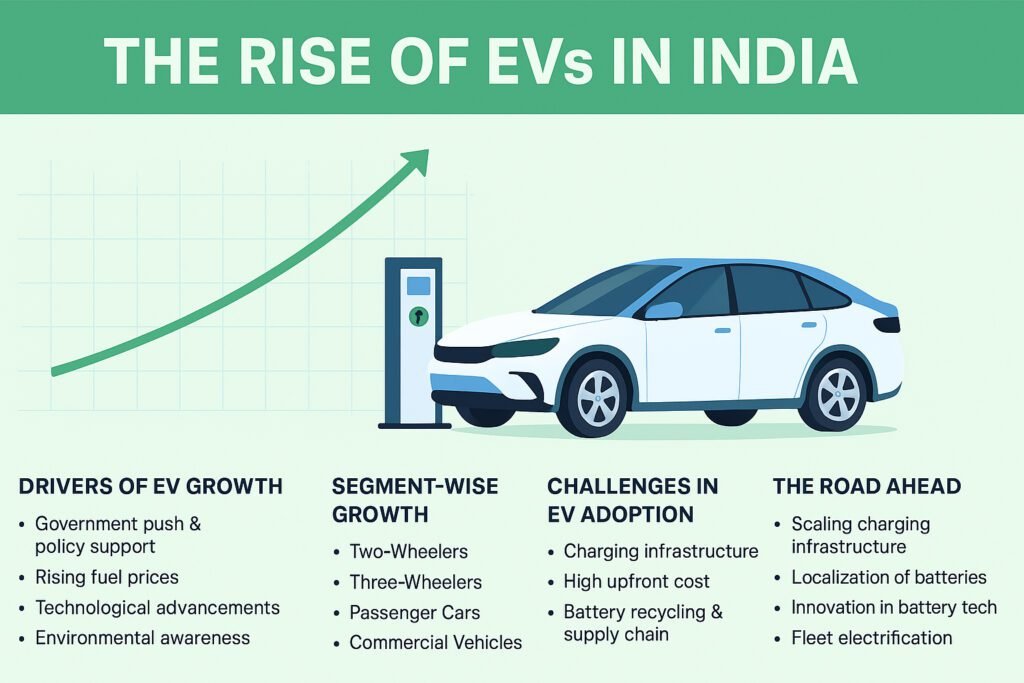India is witnessing a historic transformation in its mobility sector with the rapid rise of Electric Vehicles (EVs). Once seen as a futuristic concept, EVs are now steadily becoming part of mainstream transportation, fueled by government initiatives, rising fuel costs, growing environmental concerns, and advancements in battery technology. From two-wheelers zipping through city streets to electric buses carrying passengers across towns, EV adoption is reshaping the way Indians move.
Drivers of EV Growth in India
1. Government Push and Policy Support
The Indian government has been the primary catalyst in the EV revolution. Through programs like the Faster Adoption and Manufacturing of Electric Vehicles (FAME I & II) scheme, subsidies are being offered to manufacturers and consumers. Reduced GST on EVs (5% compared to 28% on petrol/diesel vehicles) has also made EVs more attractive. Additionally, state governments have rolled out their own EV policies with benefits like road tax exemptions, registration fee waivers, and charging infrastructure incentives.
2. Rising Fuel Prices
With petrol and diesel prices consistently climbing, Indian consumers are looking for cost-effective alternatives. EVs, which can run at one-fourth the cost of internal combustion engine (ICE) vehicles on a per-kilometer basis, have become increasingly appealing, especially for daily commuters and fleet operators.
3. Technological Advancements in Batteries
Battery technology, particularly lithium-ion, has evolved significantly over the last decade. Improvements in energy density, falling battery prices, and faster charging solutions are making EVs more practical for Indian consumers. Several companies are also investing in battery swapping models and local manufacturing to make EV ownership more convenient.
4. Environmental Awareness
Air pollution is a growing concern in many Indian cities, and consumers are more conscious of their carbon footprint. EVs, which produce zero tailpipe emissions, are increasingly seen as a cleaner alternative to ICE vehicles, helping India move closer to its climate commitments.
Segment-Wise Growth
1. Two-Wheelers Leading the Charge
Electric two-wheelers (scooters and bikes) have been at the forefront of India’s EV revolution. Affordable pricing, short-distance utility, and lower operating costs have made them a popular choice, particularly among students, delivery fleets, and urban commuters. Brands like Ola Electric, Ather Energy, and Hero Electric are witnessing soaring demand.
2. Three-Wheelers for Mass Mobility
The e-rickshaw segment has grown rapidly due to its affordability and popularity among small entrepreneurs. With low operating costs, e-rickshaws are becoming the backbone of last-mile connectivity in many Indian cities and towns.
3. Passenger Cars Slowly Gaining Traction
While still at a nascent stage compared to two- and three-wheelers, EV cars are gaining popularity among urban, environmentally conscious customers. Models like Tata Nexon EV, MG ZS EV, and Hyundai Kona are setting benchmarks for performance and affordability.
4. Commercial Vehicles and Buses
State transport departments and private operators are gradually adopting electric buses for public transit. These buses not only reduce emissions but also cut operational costs over the long run.
Challenges in EV Adoption
Despite the growth, several hurdles remain:
-
Charging Infrastructure: Limited availability of public charging stations is a major barrier.
-
High Upfront Cost: While running costs are lower, the initial purchase price of EVs, especially four-wheelers, is higher than conventional vehicles.
-
Battery Recycling & Supply Chain: Sustainable disposal and recycling of lithium-ion batteries is still in its infancy in India.
-
Consumer Awareness: Misconceptions about range, charging times, and performance often discourage buyers.
The Road Ahead
India has ambitious targets of achieving 30% EV penetration by 2030, and the journey is gaining momentum. Key areas of focus for the future include:
-
Scaling Charging Infrastructure: Both government and private companies are investing heavily in public and fast-charging networks.
-
Localization of Batteries: Domestic manufacturing under the Production Linked Incentive (PLI) scheme will reduce import dependence and bring down costs.
-
Innovation in Battery Technology: Research into solid-state batteries, sodium-ion alternatives, and advanced recycling processes will shape the next phase of EV growth.
-
Fleet Electrification: Logistics, cab services, and delivery companies are expected to lead large-scale EV adoption due to high daily mileage and cost savings.

